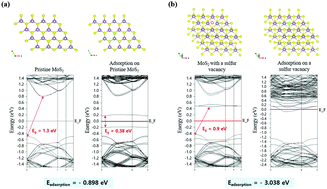当前位置:
X-MOL 学术
›
J. Mater. Chem. C
›
论文详情
Our official English website, www.x-mol.net, welcomes your
feedback! (Note: you will need to create a separate account there.)
Effect of large work function modulation of MoS2 by controllable chlorine doping using a remote plasma
Journal of Materials Chemistry C ( IF 5.7 ) Pub Date : 2019/12/12 , DOI: 10.1039/c9tc05548g Ki Hyun Kim 1, 2, 3, 4 , Ki Seok Kim 1, 2, 3, 4, 5 , You Jin Ji 1, 2, 3, 4 , Inyong Moon 2, 3, 4, 6 , Keun Heo 2, 3, 4, 7 , Dong-Ho Kang 2, 3, 4, 7 , Kyong Nam Kim 8, 9, 10, 11 , Won Jong Yoo 2, 3, 4, 6 , Jin-Hong Park 2, 3, 4, 7 , Geun Young Yeom 1, 2, 3, 4, 6
Journal of Materials Chemistry C ( IF 5.7 ) Pub Date : 2019/12/12 , DOI: 10.1039/c9tc05548g Ki Hyun Kim 1, 2, 3, 4 , Ki Seok Kim 1, 2, 3, 4, 5 , You Jin Ji 1, 2, 3, 4 , Inyong Moon 2, 3, 4, 6 , Keun Heo 2, 3, 4, 7 , Dong-Ho Kang 2, 3, 4, 7 , Kyong Nam Kim 8, 9, 10, 11 , Won Jong Yoo 2, 3, 4, 6 , Jin-Hong Park 2, 3, 4, 7 , Geun Young Yeom 1, 2, 3, 4, 6
Affiliation

|
Adjusting the intrinsic properties of 2-dimensional (2D) transition metal dichalcogenide materials is important for their various applications in electronic devices. Among them, molybdenum disulfide (MoS2) is one of the most attractive layered 2D materials because of its excellent electrical properties as well as good thermal and oxidation stability. Controlling the doping process and analyzing how the dopant atoms affect the device properties are crucial for advanced applications of TMDs. In this study, a simple and controllable chlorine doping method of MoS2 using a remote inductively coupled plasma (ICP) was studied and the effect of doping on the properties of MoS2 was investigated by adjusting the work function of MoS2. Kelvin probe force microscopy (KPFM) shows a gradual decrease of the work function with increasing chlorine radical treatment time. Chlorine doped MoS2 field effect transistors (FETs) exhibited improved electrical characteristics such as the field effect mobility and on current level as demonstrated by the transfer characteristics (Id–Vgs). Especially, the chlorine doped MoS2 FETs showed increased photoresponsivity by 1.94 times (from 424 to 824 A W−1) for green light (λ = 520 nm) and, much more interestingly, 8.59 times (from 37.6 to 323 A W−1) for near-infrared (NIR) light (λ = 785 nm).
中文翻译:

远程等离子体可控氯掺杂对MoS2的大功函数调制的影响
调整二维(2D)过渡金属二硫化二氢材料的固有特性对于它们在电子设备中的各种应用很重要。其中,二硫化钼(MoS 2)是最吸引人的2D分层材料之一,因为它具有出色的电性能以及良好的热稳定性和氧化稳定性。对于TMD的高级应用而言,控制掺杂过程并分析掺杂原子如何影响器件性能至关重要。在这项研究中,研究了一种使用远程感应耦合等离子体(ICP)的MoS 2的简单可控氯掺杂方法,并通过调整MoS 2的功函数研究了掺杂对MoS 2性能的影响。。开尔文探针力显微镜(KPFM)显示,随着氯自由基处理时间的增加,功函数逐渐降低。掺杂氯的MoS 2场效应晶体管(FET)表现出改善的电特性,例如场效应迁移率和电流水平,如传输特性(I d - V gs)所示。尤其是,掺氯的MoS 2 FET对绿光(λ = 520 nm)的光响应性提高了1.94倍(从424至824 AW -1),更有趣的是,对于绿光(λ = 520 nm),其光响应性提高了8.59倍(从37.6至323 AW -1)。近红外(NIR)光(λ = 785 nm)。
更新日期:2020-02-12
中文翻译:

远程等离子体可控氯掺杂对MoS2的大功函数调制的影响
调整二维(2D)过渡金属二硫化二氢材料的固有特性对于它们在电子设备中的各种应用很重要。其中,二硫化钼(MoS 2)是最吸引人的2D分层材料之一,因为它具有出色的电性能以及良好的热稳定性和氧化稳定性。对于TMD的高级应用而言,控制掺杂过程并分析掺杂原子如何影响器件性能至关重要。在这项研究中,研究了一种使用远程感应耦合等离子体(ICP)的MoS 2的简单可控氯掺杂方法,并通过调整MoS 2的功函数研究了掺杂对MoS 2性能的影响。。开尔文探针力显微镜(KPFM)显示,随着氯自由基处理时间的增加,功函数逐渐降低。掺杂氯的MoS 2场效应晶体管(FET)表现出改善的电特性,例如场效应迁移率和电流水平,如传输特性(I d - V gs)所示。尤其是,掺氯的MoS 2 FET对绿光(λ = 520 nm)的光响应性提高了1.94倍(从424至824 AW -1),更有趣的是,对于绿光(λ = 520 nm),其光响应性提高了8.59倍(从37.6至323 AW -1)。近红外(NIR)光(λ = 785 nm)。











































 京公网安备 11010802027423号
京公网安备 11010802027423号